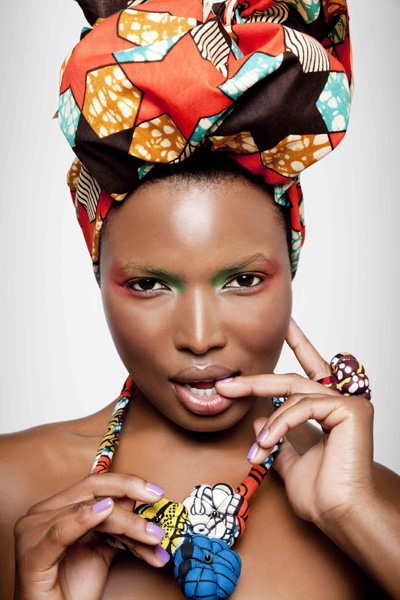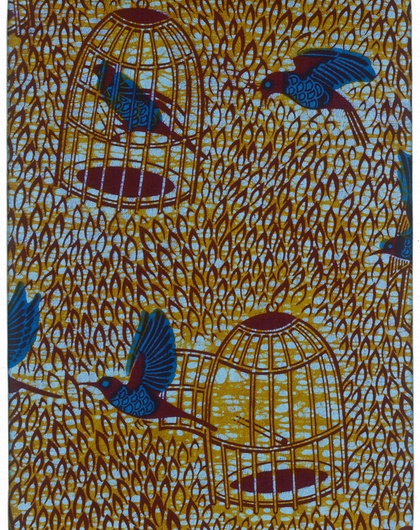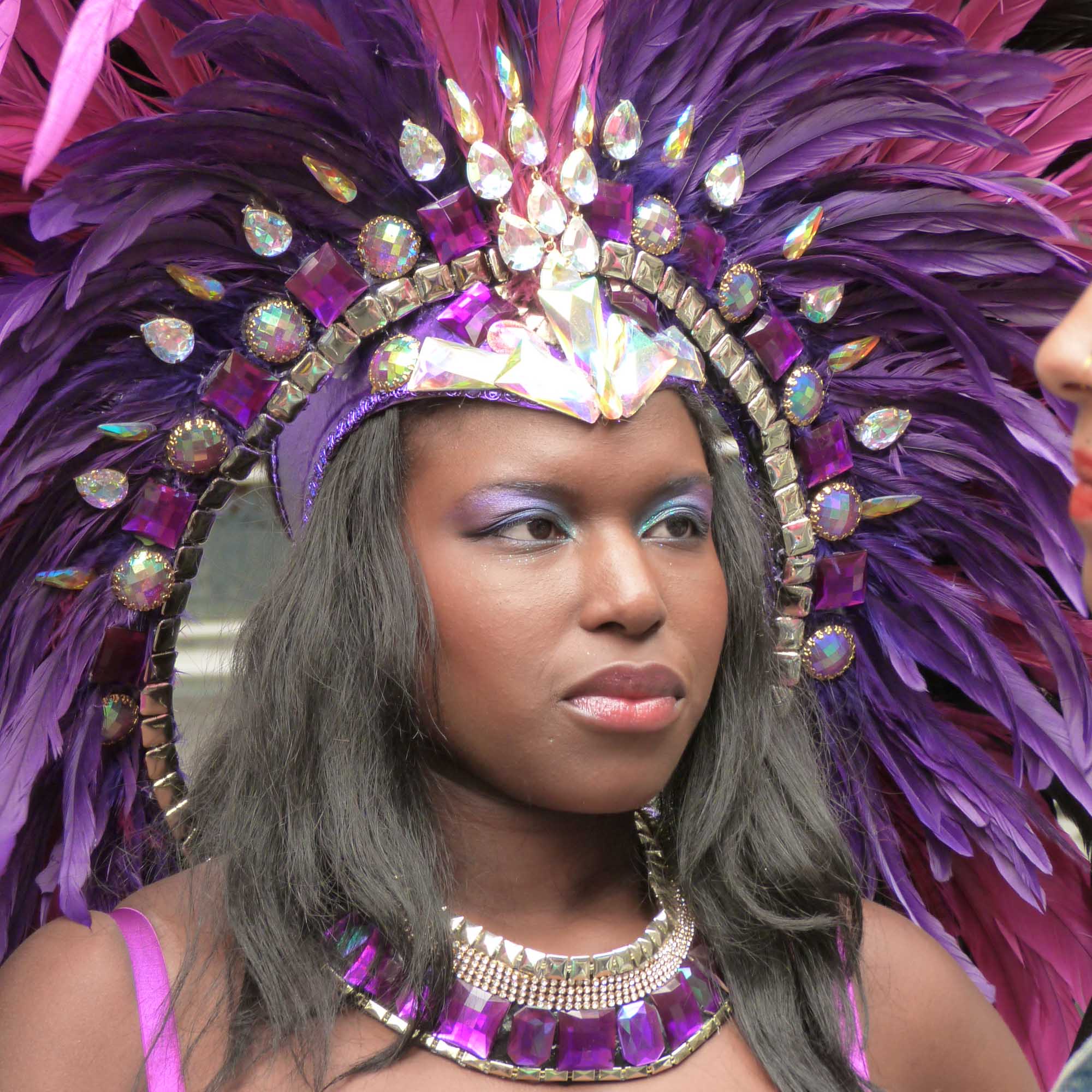A brief history of Dutch wax prints
The fascinating history of Dutch wax prints came about more by accident than design. In 19th century, the Dutch were not only established players in the gold and silk trade routes in Africa but had extended the empire into the Far East.
They were particularly interested in Java’s (Indonesia) long history of batik printing with a view to exporting it to Europe and also back to the Javanese. However the Javanese technique was both labour intensive and expensive and a cheaper mass market solution was sought.
Eventually the Dutch created a mechanised printing process but were not able to eliminate the rather quirky crackle effect in the designs. As a result, the Javanese considered the prints inferior to their own and the fashionable Europeans found a little too exotic for their genteel tastes.
Meanwhile, on the African continent, despite its own rich history of textile design, missionaries and indentured soldiers known as “black Dutchmen” were slowing introducing Dutch prints as goods and souvenirs.
With no Javanese or European market, the Dutch landed in Ghana, where the interest in their prints made them an instant success.
photo: Anna Fayemi styling: Stephanie Mousse hair MUA:Sandra Bermingham model: Sherene McNichols

In the early days, according to Vlisco, a leading a wax print manufacturer, they accepted commissions from wealthy Africans who wanted prints that depicted local folklaw, symbols and colours. The popularity of these local designs helped to boost the wax print industry into a very lucrative trade.
Traditional designs of Dutch wax prints either have literal meanings or depict local customs, beliefs or proverbs in pictorial form. Some designs are commissioned to celebrate a special event or even show solidarity to a political moment. The designs push the boundaries of colour and fizz with extremes: vivid dramatic colours against bold / abstract / geometric or figurative designs. Some designs were held in such regard they became part of a dowry package or became celebrated Dutch wax “classics”.



‘Tu sors, je sors’ (“You fly I fly”)
depicts a bird escaping and is worn by newlyweds to indicate the escaping of the cage.‘Ahonnee pa nkasa’
means ‘precious beads make no noise’‘Gramophone Apawa’
an old 1960s record album design, reminiscent of the good old days when music on disk was reserved for the privileged rich people in society.
The Dutch eventually went on to create their own designs, but it is the early African influence that played an important role in the classic wax print designs we still enjoy.
Today, the best, most authentic African prints are still to be found in Ghana. They form part of the oral tradition and have a direct connection to locality. It is a tradition that is distinctly unique to the African heritage and one that should always be celebrated.

Main photos: Anna Fayemi – styling: Stéphanie Moussé – hair and make up: Sandra Bermingham – model: Sherene McNichols
Africaninsider.com
www.educationscotland.gov.uk/higherscottishhistory/migrationandempire
“code Noir” http://jshc.org/emergence-of-the-martiniquan-gwan-wob/
http://www.academia.edu/5850952/AN_ANALYSIS_OF_SELECTED_GHANAIAN_WAX_PRINTS
EK Howard – Symbolic significance of Arican Prints: A dying phenonmenon in contemporary print designs in Ghana
Vlisco











Valley.Md
September 6, 2025 at 2:28 pmipamorelin purchase peptides
References:
Valley.Md
https://crypsante.com/kristaloftin38
September 7, 2025 at 5:18 pmhow to reconstitute 5mg ipamorelin
References:
ipamorelin and tesamorelin together, https://crypsante.com/kristaloftin38,
cjc 1295 ipamorelin how much to take
September 8, 2025 at 3:38 amcjc-1295 acetate/ipamorelin acetate
References:
cjc 1295 ipamorelin how much to take
Valley.md
September 8, 2025 at 9:42 amcjc 1295 ipamorelin blood pressure
References:
Valley.md
valley.Md
September 10, 2025 at 11:32 amcjc ipamorelin libido
References:
valley.Md
https://latenews.top/item/349332
September 11, 2025 at 9:18 pmpeg mgf with ipamorelin cjc 1295
References:
Cjc 1295 and ipamorelin For sale (https://latenews.top/item/349332)
Peg mgf with ipamorelin cjc 1295
September 12, 2025 at 3:37 pmipamorelin in pill form
References:
Peg mgf with ipamorelin cjc 1295
valley.md
September 13, 2025 at 1:25 am6 mg sermorelin 6mg ipamorelin
References:
valley.md
viddertube.Com
September 26, 2025 at 2:40 pmprosteroids
References:
best steroid Cycle for bulking and cutting (https://viddertube.com/@natashanelms68?page=about)
Https://Www.Appleradish.Org/Consuelocadman
September 27, 2025 at 1:48 amis prednisone a banned substance for athletes
References:
Steroids Information (https://Www.Appleradish.Org/Consuelocadman)
allyoutubes.com
September 27, 2025 at 4:02 amanabolic steroids urine test
References:
testosterone enanthate powder legal (allyoutubes.com)
deca sustanon and dianabol cycle
September 27, 2025 at 4:19 amDianabol Cycle: FAQs And Harm Reduction Protocols
I’ve gone through the full article you provided on “The Role of the Healthcare System in Combating COVID‑19.”
It covers:
Early detection & response – importance of rapid
testing, contact tracing and isolation to curb transmission.
Healthcare capacity – scaling ICU beds, ventilators and staff, while
protecting front‑liners with adequate PPE.
Public health measures – social distancing, mask mandates, hand
hygiene and community‑wide vaccination drives.
Data‑driven decision making – real‑time dashboards, modeling deca sustanon and dianabol cycle evidence‑based
policy adjustments.
Equity & access – ensuring vulnerable populations receive testing, treatment and vaccines.
If you’d like deeper dives into any of these sections (e.g., logistical frameworks for surge capacity or best practices in contact‑tracing
tech), just let me know!
http://gitea.shundaonetwork.com/claudeugalde6
September 27, 2025 at 5:17 amwhats better dbol or anadrol
References:
is mike rashid on steroids (http://gitea.shundaonetwork.com/claudeugalde6)
https://itimez.com
September 27, 2025 at 9:15 amanabolic pre workout
References:
Does anadrol work (https://itimez.com)
relationships
September 27, 2025 at 10:21 amWay cool! Somee extremely valid points! I appreciate you penning this article plus thee
rest of the website is really good.
Heree is my site relationships
Valley.md
September 27, 2025 at 3:06 pmbuy steroids from canada
References:
Valley.md
https://code.Ioms.cc/manuelaspringe
September 27, 2025 at 7:29 pmwhat does steroids do to the body
References:
how To buy anabolic steroids online (https://code.ioms.cc/manuelaspringe)
https://git.90acbu5aj5f.рф/chadwick15003
September 28, 2025 at 5:33 amwhere to buy real steroids
References:
steroid free bodybuilder; https://git.90acbu5aj5f.рф/chadwick15003,
tubemone.com
September 28, 2025 at 6:23 amare steroids worth the risk
References:
supplement with Steroids – tubemone.com –
gitea.nongnghiepso.com
September 28, 2025 at 8:11 amare steroids illegal
References:
synthol vs Steroids, gitea.nongnghiepso.com,
Devkona.net
September 28, 2025 at 8:47 amgnc fitness app
References:
anabolic Steroids slang Names (Devkona.net)
Farmasi Global
September 28, 2025 at 10:47 amWOW just what I was searching for. Came heere by searching for Farmasi Global
https://community.theclearwaytoconceive.com/question/the-10-scariest-things-about-headset-For-sale/
September 28, 2025 at 11:11 amwhere do anabolic steroids come from
References:
steroid cycle for women (https://community.theclearwaytoconceive.com/question/the-10-scariest-things-about-headset-For-sale/)
kandacewithak.com
September 28, 2025 at 11:36 ambest stack supplements get ripped
References:
metabolic fitness can be Achieved through – kandacewithak.com,
onverze.com
September 28, 2025 at 4:58 pmnegative affects of steroids
References:
best steroid stack for lean muscle (onverze.com)
date.ainfinity.com.br
September 28, 2025 at 11:42 pmgnc supplements to get ripped
References:
gnc pills for muscle (date.ainfinity.com.br)
gitea.tmartens.dev
September 29, 2025 at 5:03 amcutting up bodybuilding
References:
the best steroid [gitea.tmartens.dev]
https://mystdate.com/@harry660066346
September 29, 2025 at 7:56 amanabolic steroid cycle
References:
different steroids (https://mystdate.com/@harry660066346)
Valley.Md
September 29, 2025 at 8:36 amwhere to buy real steroids online
References:
Valley.Md
gitea.abra.me
September 29, 2025 at 11:10 amthe best legal steroids
References:
anabolic masster Gnc (gitea.abra.me)
https://kingpeter.ewsstagging.com
September 29, 2025 at 12:08 pmstrongest oral steroid
References:
anabolic Agent (https://kingpeter.ewsstagging.com)
Http://Git.Veilytech.Com/U/Darellbeaurega
September 29, 2025 at 5:27 pmbodybuilding drugs list
References:
Male Performance Drugs (http://Git.Veilytech.Com/U/Darellbeaurega)
gitea.dev1.aptivaai.com
September 29, 2025 at 5:43 pmadvanced steroid cycles
References:
how much anavar should i take (gitea.dev1.aptivaai.com)
doodleordie.com
September 29, 2025 at 7:43 pmwhat is the purpose of steroids
References:
Steroids weight loss; doodleordie.com,
https://git.limework.net/almafriend695
September 29, 2025 at 9:54 pmnegative effects of steroids
References:
anabolic steroids Are primarily used in an attempt to (https://git.limework.net/almafriend695)
steroids Pros and cons
September 29, 2025 at 10:09 pmsustanon steroid side effects
References:
steroids Pros and cons
home.zhupei.Me
September 30, 2025 at 1:45 amanabolic steroid supplements
References:
bodybuilding single (home.zhupei.Me)
https://bantoomusic.Com/celinda42q3254
September 30, 2025 at 2:43 amhow to build bulk muscle fast
References:
safest muscle building supplements (https://bantoomusic.Com/celinda42q3254)
goeed.com
September 30, 2025 at 6:06 amdbol headaches
References:
best gnc Supplements for muscle building (goeed.com)
vibecodetogether.com
September 30, 2025 at 7:05 amwhat is the best muscle building supplement on the market
References:
best muscle cutting supplement (vibecodetogether.com)
smartcampus-seskoal.id
September 30, 2025 at 9:02 amhow to get real steroids
References:
androgenic vs anabolic – smartcampus-seskoal.id,
isabelzarate.com
September 30, 2025 at 10:53 amtrenabol reviews
References:
is buying steroids illegal (isabelzarate.com)
https://gratisafhalen.be/author/firedchard74/
September 30, 2025 at 11:41 amwhat does deca durabolin do
References:
prescription steroid names (https://gratisafhalen.be/author/firedchard74/)
which of the following statements about anabolic steroids is false
September 30, 2025 at 1:41 pminjection for muscle growth
References:
which of the following statements about anabolic steroids is false
https://git.hantify.Ru/alisonwinfield
September 30, 2025 at 2:10 pma bomb steroid
References:
best Muscle builders at gnc (https://git.hantify.Ru/alisonwinfield)
best cutting cycle stack
September 30, 2025 at 2:46 pmsteroid stanozolol
References:
best cutting cycle stack
https://enoticias.Site/item/325748
September 30, 2025 at 3:03 pmannabolic
References:
difference between anabolic steroids and testosterone (https://enoticias.Site/item/325748)
valley.md
September 30, 2025 at 5:34 pmhow to cycle steroids
References:
valley.md
https://sistemagent.com:8081/isidra94f30909
September 30, 2025 at 7:14 pmhow to get big and cut
References:
can you buy real steroids online – https://sistemagent.com:8081/isidra94f30909,
forum.issabel.org
September 30, 2025 at 7:17 pmbuy steroid cycle
References:
Steroid stack for beginners [https://forum.issabel.org/u/talklift4]
www.24propertyinspain.com
September 30, 2025 at 10:31 pmhealth risks of steroids
References:
anabolic steroids center (http://www.24propertyinspain.com)
Enoticias.site
September 30, 2025 at 11:59 pmliquid anavar for sale
References:
which steroids are legal (https://enoticias.site/item/295882)
Jobgetr.Com
October 1, 2025 at 1:03 ambest weight gain pills for women
References:
Consequences Of Steroids (Jobgetr.Com)
www.udrpsearch.com
October 1, 2025 at 1:12 amlegal steroids for athletes
References:
how do anabolic steroids cause high blood pressure (http://www.udrpsearch.com)
Schwanger.Mamaundbaby.Com
October 1, 2025 at 1:25 amtypes of medical steroids
References:
Diseases That Cause Long-Term Or Permanent Damage Are Called (Schwanger.Mamaundbaby.Com)
wgbteam.ru
October 1, 2025 at 1:44 ambest steroid cycle for mass
References:
should Steriods be legal – wgbteam.ru,
how long for deca to kick in
October 1, 2025 at 2:21 amwhere are receptors for steroid hormones found
References:
how long for deca to kick in
fresherskiduniya.com
October 1, 2025 at 1:43 pminjection for muscle growth
References:
what is steroids good for (fresherskiduniya.com)
does
October 3, 2025 at 3:04 pmWhen you begin a 50 mg daily dose of Anavar, the changes you notice will unfold over weeks and months rather than overnight.
In the first couple of weeks, most users report a subtle increase in energy
levels and a slight improvement in muscle tone, but the real transformation starts to become visible after about four to six weeks of consistent use.
By two to three months, many people observe noticeable lean mass gains,
tighter skin, and an overall more defined physique.
It can take up to six months or longer for some users to see the full spectrum of benefits, especially
if they are also incorporating a strict diet and resistance training program.
Patience is essential because Anavar works gradually, enhancing protein synthesis while minimizing water retention, which means results appear cleaner and leaner
rather than swollen.
What Does Anavar Do?
Anavar, chemically known as oxandrolone, is
an oral anabolic steroid that was originally developed for medical conditions
such as muscle wasting and osteoporosis. In the context
of body composition, it primarily stimulates muscle
protein synthesis, leading to increased muscle mass and strength.
It also promotes nitrogen retention in the muscles,
which helps maintain lean tissue during calorie deficits or intense
training cycles. Unlike some other steroids, Anavar has a relatively mild androgenic profile, so it is less likely to
cause severe side effects such as hair loss or acne when used at moderate doses.
Furthermore, Anavar can enhance vascularity and capillary density, giving muscles a
more vascular appearance. Because it is an oral compound, it bypasses the liver’s first‑pass metabolism, making
it easier to take than injectable steroids, but users still need to be aware of potential hepatic strain.
Anavar Dosages for Females
Women seeking to use Anavar typically start with lower doses than men due to differences in body
mass and hormonal sensitivity. A common starting point is 5 mg to
10 mg per day, taken during the early part of the cycle.
This low dose allows females to experience the anabolic benefits while minimizing androgenic side effects such
as hirsutism or voice deepening. For those who tolerate the initial dose well and are looking for more pronounced results, a moderate dose of
15 mg to 20 mg per day can be considered, but it
should still remain below the maximum recommended threshold for
women. It is crucial for female users to monitor their hormone levels, liver enzymes, and overall
health during use, especially if they plan to extend the cycle beyond four weeks.
Consistency in diet—high protein intake and a slight
caloric surplus or maintenance level—is essential to support muscle growth while
using Anavar, as the steroid alone will not create mass without adequate nutrients.
https://hedgedoc.digillab.uni-augsburg.de/
October 4, 2025 at 1:20 amlegal steroids turning men into beasts
References:
https://hedgedoc.digillab.uni-augsburg.de/
https://pad.geolab.space/jU6-Jx_vQNuKlGJYndx6jw
October 4, 2025 at 3:55 pmbuy steroids usa
References:
https://pad.geolab.space/jU6-Jx_vQNuKlGJYndx6jw
https://cuwip.ucsd.edu
October 4, 2025 at 6:37 pmlegal bodybuilding drugs
References:
https://cuwip.ucsd.edu
https://www.celticsblog.com/
October 4, 2025 at 9:37 pmnegative side effects of sam-e
References:
https://www.celticsblog.com/
mlx.su
October 4, 2025 at 11:40 pmbuy injectable steroids online
References:
mlx.su
Anonymous
October 5, 2025 at 1:02 amCan you be more specific about the content of your article? After reading it, I still have some doubts. Hope you can help me.
https://king-bookmark.stream/story.php?title=dianabol-dbol-cycling-101-optimal-dosages-effective-stacks-expected-outcomes-safety-tips
October 5, 2025 at 3:36 ambest muscle building pills 2015
References:
https://king-bookmark.stream/story.php?title=dianabol-dbol-cycling-101-optimal-dosages-effective-stacks-expected-outcomes-safety-tips
https://travelersqa.com
October 5, 2025 at 3:51 amhuge pills
References:
https://travelersqa.com
forum
October 5, 2025 at 8:43 pmAnavar is one of the most popular anabolic steroids among women who are looking to enhance muscle definition while minimizing bulk.
Because of its mild nature and low androgenic activity, it
has become a go-to compound for female athletes and fitness enthusiasts seeking lean gains without
the risk of significant masculinization or estrogenic side effects.
The key to success with Anavar is careful dosing, adherence to a well‑structured
cycle, and proper post cycle therapy (PCT). Below you
will find a comprehensive guide covering safe dosing ranges, the benefits that women can expect from an Anavar cycle, how to structure a PCT for optimal recovery, and the science behind increased protein synthesis and nitrogen retention.
Anavar Cycle for Women: Safe Dosing, Benefits, and PCT Guide
for Lean Gains
A typical female Anavar cycle lasts between four and six weeks,
with most users finding that a 4‑week schedule
provides a good balance of effectiveness and safety. The recommended dose starts at 5 mg per day in the first week to assess tolerance, then increases
gradually each subsequent week until reaching a maintenance level of 10–20 mg per day.
A gradual escalation helps mitigate potential side effects such as headaches or mood changes that can arise from sudden hormone
shifts. Women who are new to anabolic steroids should stay on the lower end of this
range and monitor their bodies closely.
During the cycle, Anavar’s primary benefit is its ability to promote lean muscle growth while sparing body fat.
Because it is a selective androgen receptor modulator
(SARM)‑like compound, it encourages protein synthesis without
encouraging excessive water retention or gynecomastia.
Users often report increased muscular hardness, improved recovery times, and the capacity to push
through hard training sessions with less fatigue.
After the cycle ends, a post cycle therapy protocol is essential to restore natural hormone production and prevent side effects such as estrogen dominance or hypogonadism.
The most common PCT stack for women includes an aromatase
inhibitor (such as letrozole) at 0.25 mg daily for two weeks,
followed by a short course of a selective estrogen receptor modulator (SERM) like tamoxifen at 20 mg per day for
another week. This regimen helps suppress any residual anabolic activity while promoting the recovery of the hypothalamic‑pituitary‑gonadal axis.
Search
When looking for reliable information on Anavar dosing for women, start by consulting peer‑reviewed
scientific literature and reputable bodybuilding forums where experienced users share
their personal data. Look for studies that evaluate the
effects of low‑dose anabolic steroids on muscle mass in female
subjects; many of these papers will provide dosage recommendations that align with what
is commonly practiced in the fitness community.
Additionally, search for updated guidelines from anti‑doping agencies and medical advisories to ensure compliance with legal standards.
Increases Protein Synthesis and Nitrogen Retention
Anavar works at the molecular level by binding to androgen receptors within muscle cells, which triggers a cascade of transcription factors
that upregulate ribosomal biogenesis. This process increases the rate of
protein synthesis, allowing muscles to repair and grow more
efficiently after intense training sessions.
Moreover, Anavar enhances nitrogen retention in the body—a key
indicator of an anabolic state—by reducing the catabolic
breakdown of muscle proteins. The result is a net gain in lean tissue mass while simultaneously lowering
the likelihood of muscle loss during calorie deficits or cutting
phases.
Because women generally have lower baseline testosterone levels than men, they can experience significant improvements in muscle hardness and definition even with modest
doses of Anavar. By boosting protein synthesis without excessive androgenic activity, this compound enables female
athletes to achieve a sculpted physique while staying within safe hormonal limits.
References:
forum
https://singerpuffin89.werite.net/
October 5, 2025 at 10:47 pmpro anbolic
References:
https://singerpuffin89.werite.net/
maps.google.nr
October 5, 2025 at 11:46 pmsafe steroids for muscle building
References:
https://maps.google.nr/url?q=https://xypid.win/story.php?title=dianabol-use-guide-common-questions-safe-use-strategies
bbs.pku.edu.cn
October 6, 2025 at 2:04 amhow to get prescribed steroids
References:
bbs.pku.edu.cn
https://maps.google.fr
October 6, 2025 at 3:01 amhow dangerous are steroids
References:
https://maps.google.fr/url?q=https://duvidas.construfy.com.br/user/cirrusrod64
https://buch-samuelsen-3.technetbloggers.de/
October 6, 2025 at 8:28 pmtrenbolone reddit
References:
https://buch-samuelsen-3.technetbloggers.de/anavar-cycle-guide-maximize-results-while-reducing-risks
motionentrance.edu.np
October 7, 2025 at 3:06 amvaping and bodybuilding
References:
https://motionentrance.edu.np/profile/spoondibble6/
skipper-sahin.federatedjournals.com
October 7, 2025 at 4:51 amsteroid fat burner
References:
https://skipper-sahin.federatedjournals.com/dianabol-dbol-cycle-dosage-stacking-outcomes-and-safety-overview
https://buketik39.ru/user/spikecreek3/
October 7, 2025 at 7:49 ambody building stack
References:
https://buketik39.ru/user/spikecreek3/
unitedmusicstreaming.com
October 8, 2025 at 1:11 amgnc supplements near me
References:
https://unitedmusicstreaming.com/lynettedkz5886
bonus di riferimento binance
October 10, 2025 at 1:33 amCan you be more specific about the content of your article? After reading it, I still have some doubts. Hope you can help me.
bandar toto
October 12, 2025 at 6:57 amThank you foor any other magnificent post. Where else could anybody get
that kiund of infgo in such aan ideal means of writing?
I’ve a presentation subsequent week, and I’m at
the search for such info.
Here is myy web site bandar toto
bandar toto
October 18, 2025 at 10:29 amAw, this was an exceptionally goood post. Taking
thhe time and actual effort to create a top notch article… but what can I say…
I put things off a lot and never seem to gett anything done.
my website bandar toto
situs toto
October 18, 2025 at 5:04 pmI like the helpful information you provide inn yoiur articles.
I will bookmadk yyour weblog and check agqin here regularly.
I am quite sure I’ll learn a lott of new stuff right here!
Good luck for the next!
my page – situs toto
binance
October 19, 2025 at 4:42 pmYour point of view caught my eye and was very interesting. Thanks. I have a question for you.
Git.Saidomar.Fr
October 24, 2025 at 9:04 amlegal steroids work
References:
Steroids In America [https://git.saidomar.fr/deidreh465208]
https://matchmingle.fun/
October 24, 2025 at 9:23 amlegal consequences of steroids
References:
what are the advantages and disadvantages of common names (https://matchmingle.fun/@cindawatling12)
typical Anavar dosage for men
October 24, 2025 at 12:40 pmPublish Cycle Therapy (PCT) is an important component following the completion of any anabolic steroid routine, together with Anavar (Oxandrolone). Whereas Anavar is often described as a “mild” steroid, it nonetheless suppresses the body’s pure testosterone manufacturing — notably at greater dosages or longer cycles. Implementing a proper Anavar PCT plan helps restore hormonal stability, preserve muscle features, and prevent potential unwanted aspect effects after your cycle ends. Selecting the proper Anavar cycle and dosage is important to maximise outcomes while minimizing unwanted aspect effects.
It Is important to stress there’s no such thing as a magic pill or a magic bullet when taking fats burners or prohormones. It will rely largely on the way you eat, what your vitamin consumption is, how exhausting you prepare. Most users of Anavar find they will increase muscle size, muscle voume, and general power. Customers who take Anavar report extra muscle fullness and muscle pumps, and elevated protein synthesis. These manufacturers are recognized for their effectiveness and lower unwanted effects compared to other anabolic steroids, which can trigger vital points like hair loss and zits. Nevertheless, it’s important to prioritize safety and legality when incorporating Anavar into your routine.
https://bewellprimarycare.com/wp-Content/pgs/buy_Anavar_8.html can also be used by athletes who usually are not looking to enhance their bodily efficiency however rather simply wish to burn fats and get rid of cellulite or ingrown hairs for aesthetic functions. Reputable vendors typically ship within 1-3 business days and supply monitoring data. When buying Anavar within the USA, figuring out how to confirm product authenticity and get truthful pricing can prevent from scams and unnecessary expenses.
However, this might probably lead to legal points, as you may be misidentified as a drug cartel member, leading to an extended legal battle to prove your innocence. They push the narrative of a “secure different,” scaring potential prospects with the hazards of Anavar and the reality that it’s unobtainable from regular pharmacies and not using a prescription. They add that any try at online buy will assuredly lead to fraud. Have lost money to online sellers from “well-liked boards” without receiving your order or receiving counterfeit products. After sifting via numerous on-line articles, you’ll shortly notice that there’s little or no useful information on the topic. We’re nicely aware of the difficulty of discovering dependable sources on-line these days.
Shopping with Home Supply minimizes these risks, as we are dedicated to offering only genuine, high-quality steroids to our clients. Domestic Provide offers some of the most effective steroids for muscle achieve, together with Dianabol, Trenbolone, and Deca-Durabolin. We advocate consulting with healthcare professionals to understand one of the best choices for your wants. Yes, at Home Supply, you should purchase steroids on-line with no physician’s visit. We present a safe platform so that you just can select from a variety of high quality merchandise, ensuring a handy and discreet shopping for experience. At Maxlabs.co, we assure the protection and quality of each of our products. We make certain that we supply items solely from reliable manufacturers with a status for the high-quality manufacturing of pharmaceutical medicine.
Though Anavar is offered as a tablet and is much less likely to spoil, you may need to enhance the results of Oxandrolone by conducting a combined cycle with one other injectable drug. If a few ampoules arrive damaged, you will not be capable of get a refund of your money. Moreover, we provides detailed packaging with clear instructions to support first-time users and experienced athletes in administering the product correctly.
Be cautious of suspiciously low costs or sellers offering giant discounts on Anavar, as these could be signs of counterfeit merchandise. SteroidsOnlineUSA.com provides competitive pricing without compromising on product integrity, ensuring you get the real deal. When searching for Anavar on the market in USA, prioritize authenticity and security. Select SteroidsOnlineUSA.com for dependable products that align along with your health journey. To ensure the Anavar you buy on-line is genuine, buy from reputable suppliers like Steroidsonlineusa.com. Look for suppliers with positive critiques, business certifications, and a clear product range.
This increase improves oxygen transportation to the muscle tissue, enabling higher endurance and enhanced power during exercises. The result’s longer, extra intense training periods that speed up progress in reaching health objectives. Understanding the legal framework surrounding Anavar in the USA is essential for anyone contemplating its use. Equally essential is knowing the means to incorporate it safely and successfully right into a fitness routine to maximise advantages whereas minimizing dangers. With its distinctive capabilities, Anavar offers opportunities for enhanced efficiency when approached responsibly.
www.atn.ne.jp
October 24, 2025 at 3:43 pmwhat do bodybuilders use to cut fat
References:
http://www.atn.ne.jp/photo/album.cgi?mode=detail&no=41
rushbrainhomes.com
October 24, 2025 at 5:10 pmwhat are the effects of steroids
References:
https://rushbrainhomes.com/ideogram-ai-the-future-of-ai-powered-image-generation/
https://andrebello.com.br/
October 24, 2025 at 6:55 pmwhat is a possible side effect as a result of the presence of anabolic steroids in male users?
References:
https://andrebello.com.br/a-patagonia-de-yvon-chouinard/
Casino Es Online
October 24, 2025 at 8:33 pmGreetings, There’s nno doubt that your site cokuld bbe having browser compatibility problems.
Whenever I take a look at your webb site in Safari, it
looks fine however when opening in Internet Explorer, it’s got some overlapping
issues. I simply wanted to provide you with a quhick heads up!
Besides that, fantastic site!
Also visiut my homepage Casino Es Online
stukguitar.com
October 27, 2025 at 5:50 pmcraze bodybuilding
References:
https://stukguitar.com/@elena797489769?page=about
https://jobs.foodtechconnect.com
October 27, 2025 at 9:27 pmpowerlifting steroid cycles
References:
https://jobs.foodtechconnect.com/companies/dianabol-vs-winstrol-the-ultimate-showdown-for-muscle-growth-supremacy/
10xhire.io
October 27, 2025 at 10:16 pmwhere do you get anabolic steroids
References:
https://10xhire.io/employer/simultaneous-use-of-winstrol-and-dianabol:-is-it-safe/?/
allanstaffingagency.com
October 27, 2025 at 11:40 pmanabolic steroids stacks
References:
https://allanstaffingagency.com/employer/pepper-spray-across-europe-a-comprehensive-country-by-country-legal-overview/
https://miniurlz.com/joshualoftus18
October 28, 2025 at 12:38 amwhat happens when you get off steroids
References:
https://miniurlz.com/joshualoftus18
PedsElite
October 31, 2025 at 1:55 pmOlder former AAS users, who at the moment are getting into the age of elevated danger for cardiovascular morbidity and mortality, might therefore be expected to show an elevated fee of significant cardiovascular events. Trenbolone acetate is an artificial anabolic steroid of the nandrolone group. Despite being unlawful for human use in lots of international locations, trenbolone is utilized by some folks for increasing muscularity, power and fats loss. Half of its appeal is resistance to aromatisation, which suggests it doesn’t convert to estrogen within the body. Clenbuterol could also be extra in style than anabolic steroids with female bodybuilders because of fewer side effects. Anabolic steroids typically trigger side effects corresponding to increased facial hair, thickening of the skin, and deepening of your voice.
They have an effect on numerous parts of your physique, corresponding to your muscle tissue, hair follicles, bones, liver, kidneys, and reproductive and nervous methods. One phrase that rings true greater than ever here is the phrase ‘The poison is in the does”. No one goes to run into cholesterol issues using a wee 150mg of Testosterone per week, however bump that up tenfold and you’re positively in for a tough time. Safer choices like one of the best oral steroid with least unwanted facet effects or safest steroids for over 50 ought to all the time be prioritized. Striking a balance between optimizing gains and minimizing potential hurt, the exploration of safer steroid practices requires continual awareness and informed decision-making. This reduces the prospect of estrogen-related unwanted effects, making them safer.
This classification indicates that anabolic steroids have a moderate to low potential for physical and psychological dependence compared to substances like opioids or stimulants. Ya Clomid is pretty much a must have for ALL PFT’s it doesn’t matter what you’re using. I probably stuntded my height, I’m 5’9″ and hate it and want I was even 1 or 2 inches taller which I in all probability could be had I waited to make use of gear until my mid 20’s.
AASs are medicine derived from the modification of the testosterone molecule in order to augment or limit certain characteristics of testosterone. A examine reported in the April 2017 problem of the journal BMJ also discovered a short course of corticosteroids barely increases the risk for experiencing a broken bone and growth of a bloodstream an infection or blood clot. The terms steroids generically refers to a big group of hormones the body produces naturally in addition to similar man-made medicine. We don’t know precisely how many people abuse steroids, however it’s estimated that round one to 5 per cent of the inhabitants will do it of their lifetime. This might be in a misguided try and treat sexual dysfunction (that’s unrelated to reliable androgen deficiency), perceived “low T” or “male menopause”, or managing non-specific signs like tiredness.
GGT and bilirubin levels in serum do not appear to increase in response to exercise (111). The membrane-bound enzyme GGT is expressed within the kidneys, pancreas, spleen, lungs, mind, intestines, heart, prostate and liver – the place it is primarily expressed in areas that are wealthy in biliary epithelial cells (112). An increase in GGT is a sensitive measure of cholestatic liver disease (113). The collective improve in these serum markers ought to thus be interpreted as a sign of liver damage, even in the presence of concomitant muscular train. AAS are easily acquired by way of native dealers or the internet, even though their commerce, and sometimes additionally their use, is illegal in plenty of international locations. With an estimated international lifetime prevalence fee of three.3% (6.4% for males and 1.6% for females) (2), just about every practising physician will present care for an AAS consumer sooner or later of their profession. Although, after all, the AAS user won’t essentially disclose his use of AAS or current with unwanted side effects caused by it.
First and foremost, if you’re contemplating using steroids or are currently utilizing them, correct medical supervision is completely crucial. A healthcare professional can monitor your physical and psychological health, adjusting dosages and awaiting warning signs of psychological misery. Although trenbolone doesn’t convert to estrogen, we see progesterone mimicking certain results of estrogen in relation to physique composition.
Earlier Than we go any additional, it’s important we distinguish the difference between Primobolan and Primobolan Depot. Primobolan Depot is an injectable version of the hormone that’s connected to the large/long Enanthate ester. Primobolan is comprised of the identical active steroidal hormone in Methenolone; nonetheless, it’s connected to the small/short Acetate ester and designed for oral administration. However our experience from interviews of numerous older weightlifters, along with revealed reports in the media, suggests that the doses of AAS used in the Sixties and 70s have been typically much lower than those used at present. It must also be remembered that the majority AAS customers prior to 1980 were competitive athletes, presumably making an attempt to optimize their health and efficiency, and rarely using different illicit drugs for leisure purposes. For example, among the older athletes within the Swedish pattern, more than 80% reported that that they had never used any recreational illicit medicine in their lives.
Many young boys and adults turn out to be too concerned with their physical look, which can lead to a disordered physique image, also identified as muscle dysmorphia. This is a psychological health situation where people are constantly worrying in regards to the flaws in their physical look. It’s price noting that most skilled sports organizations ban using performance-enhancing drugs and often take a look at their athletes for illegal steroids to maintain the integrity throughout competition. Anabolic steroids should not be confused with corticosteroids, that are a completely different kind of steroid drugs generally used as anti-inflammatory agents for a variety of circumstances. This means you probably can crave the drug, require extra to get the identical effect, and have withdrawal signs if you abruptly cease taking it.
References:
https://pedselite.com/dianabol-results-quick-and-spectacular-giving-you-the-body-that-turns-heads-in-envy/29966/
Lean muscle building supplement guide
October 31, 2025 at 2:28 pmIn 2007, the Olympic runner Marion Jones was stripped of five medals received through the 2000 Olympic games after she admitted to utilizing anabolic steroids. The scandal around Main League Baseball’s Barry Bonds’s steroid use lasted years through the early 2000s, and resulted in his being convicted of perjury. This is particularly seen in women as they might expertise hair development on their face, chest, palms and different areas of the physique. This facet impact can also be depending on the kind of steroid being used and the dosage. As previously acknowledged, steroids may also end in male pattern baldness in men and women.
Its decreased androgenic exercise makes it a preferred possibility by ladies and has led to its investigation for treating catabolic situations in adults and kids (Karim et al., 1973, Ring et al., 2020). Hormones corresponding to testosterone, 5-α-DHT, and estradiol considerably influence biochemical and physiological pathways, impacting cell construction and function (Berman et al., 2003, Sarrel, 2002, Bertin et al., 2014). Though androgens play a role in estrogen synthesis, their impartial actions also contribute to physiological effects (Ceccarelli et al., 2022, Labrie et al., 2001, Smith and Batur, 2001). The word “steroid” is a broad-ranging time period used to describe any compound with a selected molecular structure—in this case, composed of 4 fused rings of 17 carbon atoms. The operate of steroids is to both keep the integrity of a cell’s membrane or activate a receptor on a cell’s surface to regulate how it behaves. If indicators of jaundice start to seem, it is suggested to hunt emergency medical help as quickly as attainable to avoid different well being risks. Performance-enhancing steroids are medication that have each physical and psychological unwanted effects.
The pressure to look or carry out a certain means can make steroids look like a fast fix, however this usually results in dependency and harmful well being consequences as users chase unattainable targets. Sure, anabolic steroids may be addictive, although they don’t create the identical instant excessive as medicine like opioids or stimulants. Over time, people who misuse anabolic steroids could develop each a physical and psychological dependence. As their tolerance builds, they usually want greater doses to attain the same results. When they cease using, withdrawal signs like fatigue, temper swings, lack of urge for food, insomnia, and despair can set in.
The evidence is so compelling that the Olympics and skilled sports activities enforce bans on testosterone use due to the unfair advantage these AAS create. These bans to maintain fair competitors are additionally a part of AAS’s allure among athletes, weekend warriors, and others. Medical Doctors sometimes prescribe anabolic steroids to treat medical situations, however individuals also use them illegally in some sports activities settings. If you or a loved one misuses anabolic steroids, it’s important to see a physician for remedy. The sooner you can tackle the problem and discover healthy alternate options, the less doubtless you are to experience doubtlessly deadly dangers sooner or later. Whereas anabolic steroids have their place within the treatment of sure medical circumstances, these medications usually are not secure for some other use.
Albuminuria, as measured by dipstick analysis, emerged or increased in 16% of the subjects (155). A larger enhance in serum creatinine levels was observed in a small 4-week placebo-controlled trial with resistance-trained males randomized to 330 mg daily of the oral prohormone 3β-hydroxy-5α-androst-1-en-17-one (1-androsterone) or placebo (38). Bioactivation of the prohormone into the potent anabolic steroid 17β-hydroxy-5α-androst-1-en-3-one (1-testosterone) results from oxidation at carbon 3 of the A-ring and reduction at carbon 17 of the D-ring of the steroid nucleus (156).
Extreme risks and potential dying are the potential penalties of injecting steroids with the IV methodology. One examine confirmed a bodybuilder who injected oil-based steroids intravenously suffered from acute respiratory distress36. This situation was not an meant IV injection; as an alternative, it mistakenly hit a vein when injecting it into the buttock https://pedselite.com/top-8-supplements-to-get-lean-and-build-muscles1/51393/. This reveals us how careful we have to be when injecting, making certain no veins or arteries are impacted.
Put simply, the use of HCG following one of the above strategies ensures you start recovering your testosterone manufacturing as soon as you begin your PCT. Long-cycle testosterone dosage will vary from 200mg/weekly on the low finish if you’re in search of HRT only… Up to 800mg or even more at the prime finish when cruising on a protracted cycle. If you’re blasting, you’ll look at even greater doses, however I’ll cover that within the quick cycle part beneath.
However if you’re new to all this, you might be shocked to learn that Anavar is derived from DHT. Despite this, Anavar does NOT come with the potent androgenic side effects of most different DHT-derived steroids. Anabolic steroid use amongst females for performance enhancement is unsurprisingly significantly lower than among males.
In Australia, steroids may be prescribed by a health care provider for medical purposes like treating androgen deficiency (low testosterone) or as a part of gender-affirming remedy. But we also use the time period steroids when we’re talking in regards to the man-made variations of those hormones. It is considered one of the least androgenic steroids, making it a high choose for those wanting muscle positive aspects without severe unwanted facet effects. Primo is called one of the least impactful Steroids recognized to man and has typically been in comparison with Anavar (Oxandrolone) in phrases of unwanted facet effects. Sure, Primo does have unwanted side effects like hair loss, testosterone shutdown, and so forth, however it’s far less unhealthy than other injectable Steroids.
There isn’t any good-quality proof indicating that AAS use is damaging to the kidneys. Nevertheless, some findings within the literature level to a potential detrimental effect. In the HAARLEM examine, a transient small improve in serum creatinine concentrations of unknown medical relevance was noticed throughout AAS use (from ninety three.1 μmol/L (1.05 mg/dL) to 97.8 μmol/L (1.eleven mg/dL)).